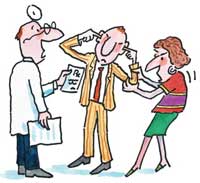Stroke: General Information, Articles
This section contains various articles on stroke. We hope that these articles will be useful to you.
First aid
Types
Effects
Rehabilitation
Rehabilitation after a stroke is a complex and versatile process aimed at eliminating the effects and encouraging the person’s adaptation, which includes the following focuses.
- Effects of a stroke and rehabilitation,
- Treatment of motor dysfunction,
- Restoration of coordination and gait,
- Occupational therapy,
- Gaining necessary daily skills,
- Restoration of swallowing,
- Restoration of communication skills, speech,
- Overcoming neuropsychiatric disorders,
- Psychological rehabilitation,
- Exercises to increase muscle strength after a stroke,
- Treatment of aphasia after a stroke,
- How to start recovery in aphasia,
- Induced restriction therapy for motor dysfunction,
- Development of finger movements,
- How to avoid falls,
- Stubbornness and unwillingness of the patient to undergo rehabilitation,
- Memory disorders after a stroke,
- Restoring the ability to read,
- Magnetic stimulation in rehabilitation,
- The benefits of honey and bee venom for recovery,
- Radon baths,
- Hippotherapy after a stroke.
Risk factors
There are two groups. The main criterion is the opportunity to influence the factor.
- Uncontrolled stroke factors
- Controlled factors - diseases and lifestyle:
- Stroke prevention
- Ultrasound for stroke prevention
- Prevention of stroke in atrial fibrillation
- Antihypertensive therapy
- Coffee against stroke
- Antioxidants in the prevention of stroke
- Magnesium to prevent stroke
- Oranges and grapefruits
- Skimmed milk
- Chocolate
- Cedar oil
- The Mediterranean diet
- Antiplatelet therapy
- Green tea and stroke
Research results
- Drawbacks of stenting in the treatment of stroke
- Commonality of risk factors for stroke and cognitive disorders
- Magnetic brain stimulation for the treatment of agnosia after a stroke
- Gene mutation doubles the risk of stroke
- Test for detecting the risk of complications
- Antithrombotic drugs in the first hours
- Reverse side of drug treatment of hypertension
- It is not safe to take painkillers after stroke
- Sleep and stroke
- Smoking significantly increases mortality due to stroke
- Migraine and stroke
- Detection of asymptomatic strokes
- Drugs used in rehabilitation
- Menopause and stroke
- Role of potassium and magnesium
- Stroke is getting younger every year
Atrial fibrillation (AF) is one of the most common tachyarrhythmias in medical practice. Atrial fibrillation is an abnormal heart rhythm accompanied by frequent arousal and atrial contraction or fibrillation of certain groups of the muscle fibers. The manifestations of this condition mainly depend on its form, but general symptoms include chaotic or rapid heartbeats, sweating, weakness, shortness of breath.The most frequent complications of atrial fibrillation are thromboembolism, heart failure and stroke. Every sixth stroke occurs in patients with atrial fibrillation. Research shows that the risk of stroke with AF increases with age: at the age of 60 the stroke rate is 2,8%, at the age of 70 it reaches 10% and at the age over 80 it accounts for 23%. The treatment of this disease depends on its form (constant or paroxysmal) and in most cases involves medication.
 It is very common for the patients to be somehow stubborn, negligent and reluctant when undergoing post-stroke rehabilitation which in many ways complicates the already difficult recovery process. Below are some of the most common manifestations. The patient’s family should carefully consider these typical situations and prevent their occurrence.
It is very common for the patients to be somehow stubborn, negligent and reluctant when undergoing post-stroke rehabilitation which in many ways complicates the already difficult recovery process. Below are some of the most common manifestations. The patient’s family should carefully consider these typical situations and prevent their occurrence.
In some cases, the symptoms of stroke may be unpronounced. If the condition does not have obvious manifestations, it does not mean that it is less dangerous. In this case the patient should undergo tests to determine three signs (described above)! Example: person’s mood changes suddenly without any reason/after a fall, which can also be an effect of stroke.
The likelihood of developing cognitive neurological disorders, including people who have not suffered any stroke, increases due to high blood pressure and other risk factors for stroke.
For example, have you ever suddenly found yourself in a garage with an unknown purpose? Do you often experience difficulties with names? Do you often worry for the iron you left plugged in?
The researchers discovered that those women who eat foods rich in antioxidants are less likely to develop cardiovascular diseases.
Dyslexia or inability to read can be one of the possible effects of stroke. Such complication can occur even with the preservation of speech function or ability to write.
Those who eat food rich in magnesium every day, such as green vegetables, nuts, beans, are less likely to develop stroke.
The patients with post-stroke unilateral spatial agnosia who had undergone a two-week course of transcranial magnetic stimulation showed significant improvements during the clinical trials.
According to scientists, both oranges and grapefruits can protect body from the risk of stroke due to their antioxidant properties.



